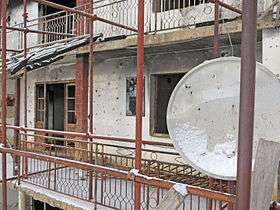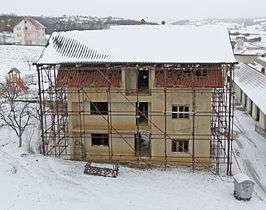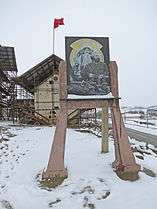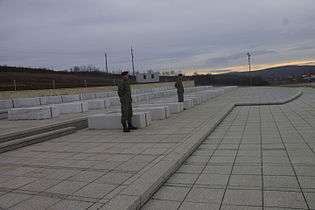Attack on Prekaz
| Attack on Prekaz | |||||
|---|---|---|---|---|---|
| Part of the Kosovo War | |||||
| |||||
| Belligerents | |||||
|
|
| ||||
| Commanders and leaders | |||||
|
|
| ||||
| Strength | |||||
|
|
| ||||
| Casualties and losses | |||||
| 2 policemen killed, seven wounded[4] | 58 Kosovo Albanians killed, including eighteen women and ten children[5] | ||||
The Attack on Prekaz was an operation led by the Special Anti-Terrorism Unit of Serbia on 5 March 1998. Police said they were trying to capture "terrorists"; according to Amnesty International, all evidence suggests that the attack was not intended to apprehend armed Albanians, but "to eliminate the suspects and their families".[6] During the operation, Kosovo Liberation Army (KLA) leader Adem Jashari and his brother Hamëz were killed, along with more than 60 other family members.
Background
Adem and Hamëz Jashari were members of the Kosovo Liberation Army (KLA), a militant group of ethnic Albanians that sought the independence of Kosovo from Yugoslavia. Adem Jashari was responsible for organizing the first armed political formation in Srbica (Skënderaj in Albanian) in 1991.[7]
Pursuing Adem Jashari for the murder of a Serbian policeman, Serbian forces again attempted to assault the Jashari compound in Prekaz on 22 January 1998.[8] On 28 February 1998, a firefight erupted between Albanian militants and a Serbian police patrol in the small village of Likošane. Four Serbian policemen were killed and several were injured. The KLA militants, one of whom was Adem Jashari, escaped. Subsequently, Serbian police killed thirteen people in a nearby household. Later that same day, Serbian policemen attacked the neighbouring village of Ćirez and subsequently killed 26 Albanians. However, the Albanian militants who had incited the violence managed to escape and the police decided to move in on Adem Jashari and his family. A long-time radical hardliner in the Drenica valley, Jashari decided to stay in his home and he instructed his fighters to stay there as well and resist to the last man.[9]
Operation
On 5 March 1998, the KLA launched another attack on a police patrol in Donji Prekaz, which caused the Serbian police to seek retribution, according to the official Serbian public report.[10] After the second attack, the police prepared a brutal response for the Jasharis. They started hunting down local KLA militants who were forced to retreat to Jashari's compound in the same village.[4] Yugoslav policemen surrounded the group and invited them to surrender, while urging all other persons to clear the premises. The police further alleged that they gave them two hours to comply. Within the given deadline, dozens of civilians complied with the order and dispersed in safety from the stronghold.[4] According to the police, after the two-hour deadline had expired, Adem Jashari, his brother and most of his family-members, however still refused to comply and remained inside the compound. After a tense verbal stand-off, according to official Serbian statements, Jashari's group responded by firing on the police using automatic weapons as well as mortars, hand grenades and snipers, killing two and injuring three policemen.[4] In the ensuing violence, the Yugoslav police killed more than sixty people, including both Jashari brothers. The only survivor was Besarta Jashari, Hamëz Jashari's daughter.[11] She claimed that the policemen had "threatened her with a knife and ordered her to say that her uncle (Adem Jashari) had killed everyone who wanted to surrender." [11] Goran Radosavljević, a major in the Serbian Interior Ministry, claimed that "Adem Jashari used women, children and the elderly as hostages...".[12] General Nebojša Pavković stated that "It was a normal policing action against a well-known criminal. It was successful. The other details I don't remember".[13]
Evidence gathered later showed that the attack wasn't intended to apprehend of armed Albanian "militants"; rather, the attack was to eliminate them and their families.[10] Other houses of Jashari family members were also attacked by the police as well as the residential compound of the Lushtaku family.[10] In response, the UN security council turned to Chapter VII of the United Nations Charter without authorizing the final measure of the chapter which was military intervention.[14] Mortars fired on houses, and snipers shot those who fled.
Burial
The local Council for the Defense of Human Rights and Freedoms was contacted by the police to collect the bodies, but when the council requested documentation about the deceased none was made public. According to the Council, the police had moved the corpses to a Pristina morgue before returning them to the Drenica area. On 9 March, the police warned that if the bodies weren't buried by their families they would be buried by the authorities, while the families requested autopsies to be performed.[2]
On 10 March, the police got a bulldozer and dug a mass grave near Prekaz, and buried the bodies, ten of which were still unidentified at that time. Families had hoped that autopsies might be performed, but a group of doctors from Pristina, the families of the deceased, representatives from the Catholic Church, the Muslim community and international human rights organizations were denied access to the area. The heads of the Serbian police accused the organizations that they had smuggled weapons into the region in the past.[2] On 11 March the bodies were reburied according to Islamic tradition.[15]
42 individuals, Albanians, were identified to have died in Donji Prekaz during the operation.[16] 6 Albanians died in the nearby village of Lauša under unclear circumstances.[16]
Aftermath
The Prekaz attack led to a rapid increase of the KLA's popularity among ethnic-Albanians and village militias were formed in many parts of Kosovo.[17] After the event, Adem Jashari himself was portrayed as a "terrorist" in the Yugoslav media, while the Albanian media depicted him as a "freedom fighter". The casualties of the attack would be described as the fall of "martyrs" in the Albanian media, while in the Serbian media they were reported to be "collateral effects of the fight against terrorism".[11] On 13 March, about 50,000 people demonstrated against the attacks, while on 15 March, the Catholic Church called for masses to be held throughout the region, after which about 15,000 people demonstrated in Pristina.[18]
In late March 1999, more than 100,000 people marched in eight American cities and European capitals to protest the attack.[19] Eventually, events spiralled out of control and the Kosovo War ensued.
Pictures of the Adem Jashari Memorial in Prekaz
-
One of the houses attacked by the Serbian police
-

The surrounding of the house has been secured by a metal construction
-

Bullet holes and damage done by grenades is still visible outside...
-
...and inside the house
-

Picture of Adem Jashari on the steel construction
-

Another attacked house in Prekaz
-

Commemorative plaque
-

Steel in memory of Smajl A. Jashari
-

Exhibition hall
-

Fallen of Prekaz
See also
References
- ↑ war crimes tribunal collection, John Oppenheim, Willem-Jan van der Wolf, Global Law Association, 2003
- 1 2 3 Under Orders: War Crimes in Kosovo. Human Rights Watch. 2001. pp. 34, 96–7.
- ↑ "Clashes in Kosovo leave at least 22 dead". CNN. 5 March 1999. Retrieved 28 November 2012.
- 1 2 3 4 "Kosovo killings: Belgrade's official version of events". BBC. 12 March 1998.
- ↑ Judah 2002, p. 140.
- ↑ Krieger, Heike (2001). The Kosovo Conflict and International Law: An Analytical Documentation 1974-1999. Cambridge University Press. p. 96. ISBN 0-521-80071-4.
- ↑ "ICTY/ LIMAJ, Fatmir/ Judgement, ICTY/ BALA, Haradin/ Judgement, ICTY/ MUSLIU, Isak/ Judgement". sim.law.uu.nl. 2011-03-00. Archived from the original on 6 October 2014. Retrieved 1 October 2014. Check date values in:
|date=(help) - ↑ Elsie 2011, p. 142.
- ↑ Henriksen 2007, p. 127.
- 1 2 3 Rights Watch: Violence in Kosovo
- 1 2 3 Kolstø, Pål (2009). Media Discourse and the Yugoslav Conflicts: Representations of Self and Other. Ashgate Publishing, Ltd. p. 96. ISBN 978-0-7546-7629-4. Retrieved 19 April 2012.
- ↑ Henriksen 2007, p. 128.
- ↑ "Behind the Kosovo crisis". BBC. 12 March 2000. Retrieved 6 October 2013.
- ↑ Hodge, Carl Cavanagh (2002). NATO for a New Century: Atlanticism and European Security. Greenwood Publishing Group. p. 111. ISBN 978-0-275-97594-4. Retrieved 20 April 2012.
- ↑ Abrahams & Andersen 1998, p. 31.
- 1 2 Abrahams & Andersen 1998, p. 32.
- ↑ Hudson, Kimberly A. (2009-03-05). Justice, Intervention, and Force in International Relations: Reassessing Just War Theory in the 21st Century. Routledge. p. 138. ISBN 978-0-415-49025-2. Retrieved 19 April 2012.
- ↑ Clark, Howard (2000-08-20). Civil Resistance in Kosovo. Pluto Press. p. 175. ISBN 978-0-7453-1569-0. Retrieved 20 April 2012.
- ↑ Hockenos, Paul (2003). Homeland Calling: Exile Patriotism & the Balkan Wars. Cornell University Press. p. 247. ISBN 978-0-8014-4158-5. Retrieved 19 April 2012.
Sources
- Abrahams, Fred; Andersen, Elizabeth (1998). Humanitarian Law Violations in Kosovo. Human Rights Watch. pp. 30–32. ISBN 978-1-56432-194-7.
- Judah, Tim (2002). Kosovo: War and Revenge. Yale University Press.
- Henriksen, Dag (2007). Nato's Gamble: Combining Diplomacy and Airpower in the Kosovo Crisis, 1998-1999. Naval Institute Press.